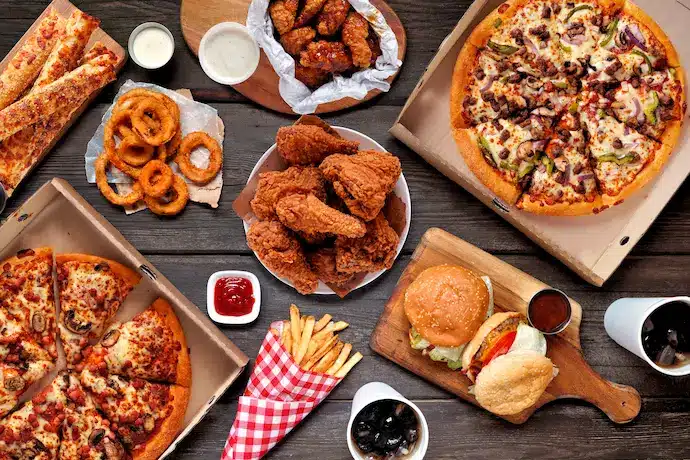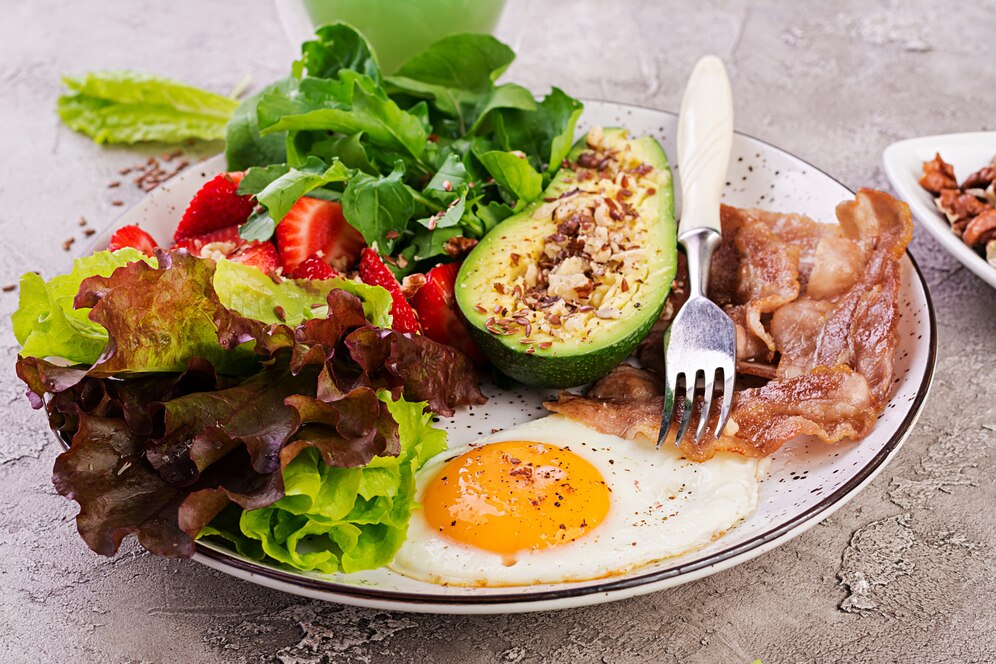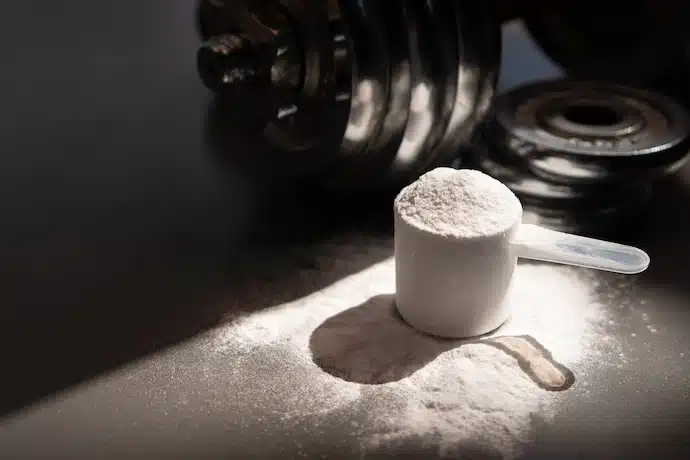Struggling to gain muscle but unsure how to bulk for muscle gain? A dirty bulk might seem like the fastest way to pack on size. This strategy involves eating a calorie surplus, often from less healthy foods, to see quick results.
Keep reading if you want to know what is a dirty bulk and whether it’s worth it!
Key Takeaways
- Dirty bulking involves eating a calorie surplus with less focus on food quality, using high-calorie foods like pizza and burgers to gain muscle quickly.
- It leads to faster weight gain but risks include higher fat gain (up to 15%) and potential health issues like heart disease or diabetes.
- Clean bulking, in comparison, focuses on nutrient-dense foods for steady growth with minimal fat increase (around 2%).
- Strength training is essential during dirty bulking; aim for compound exercises and consume 1g of protein per pound of body weight daily.
- Tracking caloric intake through apps like MyFitnessPal helps maintain balance between rapid muscle gains and health outcomes.
What Is Dirty Bulking?
Dirty bulking is an aggressive weight gain method. It focuses on consuming a large calorie surplus to build muscle fast. Unlike clean bulking, it doesn’t prioritize eating nutrient-dense foods.
Instead, people often rely on high-calorie processed foods like pizza, burgers, or ice cream. The goal is rapid muscle growth but with less concern for fat gain.
This approach appeals to gym bros aiming for size without strict dieting rules. You’ll pack on both mass and body fat by eating junk food alongside protein-rich meals like chicken or Greek yogurt.
While it works for gaining weight quickly, it may lead to health risks and excess fat storage.
Next, explore how dirty bulk compares to clean bulk in benefits and drawbacks!
Dirty Bulk vs. Clean Bulk
Dirty bulking pushes rapid weight gain with less focus on food quality, while clean bulking prioritizes nutritious, whole foods for steady growth. Both methods aim to build muscle but take very different roads to get there.
Key Differences
Clean bulking focuses on nutrient-dense foods such as whole grains, lean meats, and vegetables. It supports muscle building with a moderate calorie surplus while minimizing fat gain.
Dirty bulking includes consuming high-calorie items, often junk food or processed options like burgers, fries, and sodas. This method leads to rapid weight gain but can result in increased body fat.
With clean bulking, you receive vitamins and minerals essential for maintaining good health. It lowers risks of heart disease or type 2 diabetes by avoiding trans fats and added sugar.
On the contrary, dirty bulking heavily depends on empty calories that lack necessary nutrients. Although both approaches aim for muscle growth through strength training and resistance exercises, the long-term health outcomes differ significantly between them.
Pros and Cons of Each
Both dirty bulking and clean bulking have their upsides and downsides. Your choice depends on goals, lifestyle, and how much fat gain you can tolerate during weight gain.
Dirty Bulking Pros:
- Easier to hit a calorie surplus since you can eat high-calorie processed foods like pizza or burgers.
- Faster weight gain occurs when paired with resistance training or strength training.
- Allows flexibility with food choices—eat what you want without guilt or strict rules.
- Useful for bodybuilders aiming to bulk up quickly during off-season periods.
Dirty Bulking Cons:
- High fat-to-muscle ratio due to consuming empty calories from junk food and saturated fats like fries or cola soda drinks.
- Risk of heart disease, diabetes, and chronic diseases if relying too much on unhealthy options.
- May lead to nutritional deficiencies because these diets lack nutrient-dense foods like whole eggs or leafy greens.
- Potential for belly discomfort from excessive eating habits—it’s hard on your gut microbiome.
Clean Bulking Pros:
- Builds more lean tissue while minimizing fat mass over time due to better food sources such as Greek yogurt or whole grains.
- Supports recovery after hypertrophy training thanks to steady protein intake from lean meats, soybeans, or fish.
- Better long-term health outcomes since it focuses on nutrient-dense meals rich in polyunsaturated fats and complex carbs.
- Fewer risks of vitamin D deficiency, magnesium deficient states, or other nutrition-based problems compared to dirty bulks.
Clean Bulking Cons:
- Slower muscle growth since the caloric surplus is harder to achieve with cleaner options like quinoa bowls instead of fast foods.
- More effort is needed for meal planning and cooking healthier food daily for diet plans that suit your gains roadmap.
- Less freedom means skipping out on cravings such as fried snacks that gym-goers might love indulging in frequently!
How to Dirty Bulk Effectively
Packing on muscle fast takes strategy, not guesswork. Focus on what you eat and how you train to see real gains.
Choosing Calorie-Dense Foods
Load up on high-calorie foods like fried chicken, beef burgers, pizza, or even ice cream to boost your weight gain. Snacks like cookies, chips, and processed desserts can quickly add calories too.
Sports drinks with sugar provide extra energy between meals but don’t skimp on protein intake either.
Add calorie-dense yet nutrient-packed options for a healthier spin. Nuts, seeds, olive oil, and whole dairy are great for this purpose. Pair lean meats like chicken thighs with rice or pasta to maximize carbs and essential amino acids for muscle growth.
Tracking Your Caloric Intake
Hitting a 300-500 calorie surplus every day is key for steady weight gain. Aim to add 0.5–1 pound per week over 16–26 weeks—no more, no less. Use apps like MyFitnessPal or Cronometer to track your caloric intake without guesswork.
These tools calculate everything from carbs to omega-3 fatty acids.
Eyeballing portions can lead to mistakes, so measure foods carefully. Tally up snacks too—those junk food bites stack up fast! Greek yogurt and nuts are great high-calorie options that provide protein and dietary fat, fueling strength training sessions better than empty calories from soda or chips.
“What gets measured gets managed.”
Incorporating Strength Training
Strength training is a must for dirty bulking. Consuming a calorie surplus won’t translate to muscle gain without resistance training. Free weights like dumbbells and barbells are excellent tools for building lean body mass.
Aim for compound exercises such as squats, deadlifts, and bench presses to target multiple muscles at once. These moves help you lift heavier over time, boosting growth.
Protein intake plays a key role too. Low protein diets, like those with only 5% of calories from protein, stunt muscle gains during weight gain phases. Shoot for about 1 gram of protein per pound of body weight daily—this supports recovery after tough workouts.
Progressively overload your muscles by increasing weight or reps weekly, ensuring continuous strength improvements while reducing extra fat gain.
Potential Downsides of Dirty Bulking
Dirty bulking can result in unnecessary fat gain, health concerns, and poor body composition—read further to discover ways to address these risks.
Risk of Excess Fat Gain
Piling on calories without care can lead to an increase in fat rather than muscle. Studies show dirty bulking may result in a 15% fat increase, compared to just 2% with controlled diets.
Excess body fat impacts your body composition and could make later fat reduction more challenging.
Untrained bodies tend to store more excess energy as fat instead of building muscle. Consuming junk food and high-calorie processed foods exacerbates this issue. Excess visceral fat raises risks for heart complications, making dirty bulking less appealing over time.
Nutritional Deficiencies
Dirty bulking often overloads your plate with junk food and empty calories. These choices lack vital nutrients such as B vitamins, folate, and dietary protein. Over time, this may result in being undernourished regardless of consuming large amounts of high-calorie foods.
Nutrient deficiencies significantly impact muscle recovery, energy levels, and performance in strength training.
Excessive sugar intake from processed foods disrupts your health, increasing the risks of chronic diseases like diabetes or heart disease. Depending on vegetable oils or low-quality fats can also mean missing out on essential fatty acids that are crucial for building a strong body composition.
As Arnold Schwarzenegger once said:.
The worst thing I can be is the same as everybody else. Don’t let poor nutrition set you back!
Tips for Successful Bulking
Smart eating and solid training can keep your bulk on track, so focus on balance without sacrificing health—read on for more!
Balance Between Calories and Nutrition
Eating only high-calorie foods won’t maximize muscle growth. You need a balance of protein, carbs, and healthy fats. Aim for 30% of your calories from protein or about 0.8g per pound of body weight.
Include complex carbs like brown rice or oats to make up 50% of daily intake. Focus on unsaturated fats such as those in avocados and nuts—20% is the ideal target.
Junk food may add calories but lacks important nutrients like folate or polyphenols needed for good health. Processed foods might lead to fat gain without improving strength training results.
Choose nutrient-dense options instead, such as Greek yogurt or lean meats, which deliver amino acids essential for muscle repair and growth while keeping fat gains lower than empty calorie sources do.
Check out meal planning strategies next!
Importance of Meal Planning
Keeping the right balance of calories and nutrition is easier with proper meal planning. It helps you avoid empty calories from junk food and focus on nutrient-dense options like lean meats, Greek yogurt, and whole foods.
Planning your meals means you can track your calorie surplus better while hitting key macronutrient targets like protein intake for building muscle.
Skipping meal planning might lead to filling up on processed foods low in essential nutrients. This could risk folate deficiency or even cause long-term issues like chronic diseases linked to saturated fat overconsumption.
Using tools such as a free meal prep toolkit or opting for Trifecta A La Carte delivery ensures you’re feeding your body high-calorie foods without sacrificing quality.
Clean Bulking as an Alternative
Clean bulking focuses on eating whole foods and watching portions, making it a smarter way to build muscle without packing on too much fat—worth considering for lasting results!
Benefits of Clean Bulking
Eating nutrient-rich foods during clean bulking helps build muscle with less fat gain. Whole foods like lean meats, Greek yogurt, and vegetables provide essential amino acids, vitamins, and minerals.
This supplies energy for strength training while enhancing body composition over time. It promotes long-term health by avoiding processed foods and excess saturated fats.
A calorie surplus from balanced meals fuels workouts without unnecessary calories adding fat. Clean bulking lowers risks of chronic diseases like heart disease compared to strategies heavy in junk food.
You’ll gain more lean mass while maintaining better health overall. Plus, staying consistent establishes habits for eating healthier even outside weight-gain phases.
Comparison to Dirty Bulking
Sure, here’s a simple comparison to help break it down for you, Gym-Bros. Let’s discuss how clean bulking compares to dirty bulking in an easy-to-follow table:
| Category | Dirty Bulking | Clean Bulking |
|---|---|---|
| Calorie Intake | Sky-high, often without limits. Includes junk food to hit daily goals. | Controlled, with a slight surplus. Emphasis on quality food sources. |
| Fat-to-Muscle Ratio | Higher fat gain, typically 15% fat increase as per studies. | Lower fat gain, closer to a 2% fat increase over time. |
| Food Choices | Anything goes—pizza, burgers, donuts, all on the table. | Leans on cleaner foods like lean meats, veggies, and complex carbs. |
| Recovery Benefits | Faster recovery due to calorie surplus, but increases inflammation risk. | Recovery is efficient, supported by nutrient-dense meals. |
| Body Composition | Leads to rapid weight gain but also includes noticeable fat storage. | Promotes steady muscle growth with minimal fat accumulation. |
| Transition to Cutting | Makes cutting harder because of excess fat gained. | Easier transition due to lower fat accumulation. |
| Training Impact | Plenty of energy for heavy lifts but may feel sluggish. | Consistent energy without the crash of greasy junk food. |
| Long-Term Results | More muscle, but often masked by high fat levels. Can increase health risks. | Leaner gains with better health and athletic performance. |
This comparison should help you decide which strategy aligns with your goals and lifestyle.
Conclusion
Dirty bulking packs on muscle fast, but it comes with baggage—like extra fat. It’s a wild ride of calorie overload and strength training. Some thrive on the approach, others crash from poor food choices.
If you try dirty bulking, aim to balance high-calorie meals with smart nutrition. Your gains depend on how well you fuel your body!
FAQs
1. What is dirty bulking?
Dirty bulking is an aggressive weight gain strategy where you eat a calorie surplus, often from high-calorie and processed foods, to maximize muscle growth quickly.
2. How does dirty bulk differ from clean bulk?
Dirty bulk focuses on eating junk food and empty calories for fast weight gain, while clean bulk emphasizes nutrient-dense foods like lean protein and whole grains to improve body composition with less fat gain.
3. Can dirty bulking lead to health problems?
Yes, relying on saturated fat and processed foods during a dirty bulk can increase the risk of heart disease, chronic diseases, and nutrient deficiencies over time.
4. Is resistance training necessary during a dirty bulk?
Absolutely! Resistance training combined with strength exercises helps ensure the extra calories go toward muscle gain instead of just fat storage.
5. Are there better alternatives to junk food in a calorie surplus?
Yes! Foods like Greek yogurt, nuts, or carbohydrate-rich options are great choices for adding healthy calories without sacrificing nutrients or amino acids essential for muscle repair.
6. Does dirty bulking affect long-term body composition?
It can negatively impact body composition by increasing fat gain alongside muscle growth if not managed carefully with balanced protein intake and proper exercise routines like cardio or strength training sessions regularly included in your plan!





